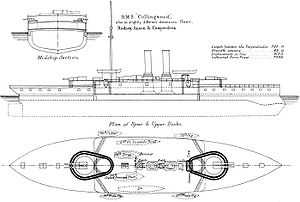HMS Collingwood (1882)
.jpg) HMS Collingwood photographed from her port quarter. | |
| Career | |
|---|---|
| Name: | HMS Collingwood |
| Namesake: | Admiral Cuthbert Collingwood |
| Builder: | Pembroke Dockyard |
| Laid down: | 12 July 1880 |
| Launched: | 22 November 1882 |
| Completed: | July 1887 |
| Fate: | Broken up, 11 May 1909 |
| General characteristics [1] | |
| Class and type: | Admiral class |
| Type: | Pre-dreadnought battleship |
| Displacement: | 36 ft 8 in (11.18 m)9,500 tons |
| Length: | 325 ft (99 m) p.p. |
| Beam: | 68 ft (21 m) |
| Draught: | 26 ft 4 in (8.03 m) |
| Installed power: | 7,000 ihp (5,200 kW) (normal) 9,600 ihp (7,200 kW) (forced draught) |
| Propulsion: | 2 × Humphries compound inverted steam engines 2 × screws |
| Speed: | 15.5 kn (17.8 mph; 28.7 km/h) (normal) 16.8 kn (19.3 mph; 31.1 km/h) (forced draught) |
| Complement: | 498 |
| Armament: |
|
| Armour: |
|
HMS Collingwood was an ironclad battleship of the Royal Navy. She was the first example of the Admiral-class and was named after Admiral Cuthbert Collingwood, Horatio Nelson's second-in-command in the British victory at the Battle of Trafalgar.
Design


_stern_view.jpg)
At the time of her design, she was not considered as being the forerunner of any class; she was designed by Barnaby as a one-off as an answer to the French Formidable-class, which carried three heavy guns on the centre line and a number of smaller pieces on the broadside. He made several proposals to the Board of Admiralty, including an improved Inflexible, an improved Dreadnought, and an improved Italia, all of which were rejected.[2]
His final submission, which became HMS Collingwood, was a return to the configuration of Devastation, but with the centerline-mounted breech-loading main armament mounted in barbettes, which allowed them to be sited 10 ft (3.0 m) further above the waterline than Devastation 's guns.[3] It set the pattern for every British battleship designed thereafter until the revolutionary Dreadnought.
She was built to a requirement that she should not exceed 10,000 long tons (10,000 t) displacement. She was also built with sufficient engine power to achieve—with forced draught—a speed of over 16 kn (18 mph; 30 km/h). In order to achieve this speed on the displacement it was found necessary to give her a low freeboard, which meant that when steaming into wind she would bury her bow in the sea and take green water onto her forecastle, negating the extra power of her engines.
The mounting of the main armament in barbettes allowed the guns to be deployed at a height above water of 22 ft (6.7 m), some 10 ft (3.0 m) higher than in Colossus. This gave them a better overall command, and increased their ability to deliver plunging fire onto the decks of enemy ships. As the two pairs of guns were contained in individual, widely spaced armoured redoubts, there was no possibility of a single incoming shell disabling all of the main armament. Each barbette was a roughly pear-shaped 11-sided polygon, 60 ft × 45 ft (18 m × 14 m). The guns—mounted on a turntable—could only be loaded when pointed fore and aft with an elevation of 13°. The 6 in (150 mm) secondary armament was grouped in a central broadside battery, and the quick-firing tertiary armament was positioned over the broadside battery on the hurricane deck.
Collingwood was the first Royal Navy battleship to be equipped with forced draught.[4] This was a system in which air was forced into the furnaces at above atmospheric pressure to increase the rate of fuel combustion and hence the amount of steam produced.
Authorized in 1880, Collingwood 's hull was launched in 1882, and she was completed in 1887, being commissioned the same year.
Service
Collingwood was commissioned at Portsmouth on 1 July 1887 for Queen Victoria's Golden Jubilee Military Review, and was paid off into Reserve in August. She was posted to the Mediterranean, where she served from November 1889–March 1897. She was coastguard ship at Bantry from March 1897–June 1903, when she paid off into the reserve, where she remained until sold.
Notes
References
- Brown, D.K. Warrior to Dreadnought. London: Caxton Editions, 2003. ISBN 1-84067-529-2.
- Oscar Parkes, British Battleships. ISBN 0-85052-604-3
- Chesneau, Roger; Koleśnik, Eugène M.; Campbell, N.J.M. (1979). Conway's All the World's Fighting Ships, 1860–1905. London: Conway Maritime Press. ISBN 0-85177-133-5.
External links
| Wikimedia Commons has media related to HMS Collingwood (ship, 1882). |
| ||||||||||||||